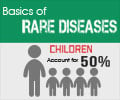As much as 10 percent of the world's population suffers from a rare disease, which translates into hundreds of millions of people, said new study.

‘As much as 10 percent of the world's population suffers from a rare disease, which translates into hundreds of millions of people.’





A big part of the problem has to do with definitions, the authors argue, because the inability to reliably diagnose a rare disease hinders researchers' ability to develop treatments for it.
In the U.S., the Orphan Drug Act of 1983 defines a rare disease as one affecting fewer than 200,000 people. In the European Union, legislation introduced in 2000 defines it differently: when fewer than one in 2,000 people is affected. And, the authors point out, a disease that is considered "rare" in the general population might be relatively common within a subgroup - examples include Tay-Sachs disease among Ashkenazi Jews and sickle cell disease among people of sub-Saharan African descent.
Another complicating factor is that the terms used to define diseases are often inconsistent and imprecise, and they sometimes vary from country to country. For example, "breast cancer" actually encompasses a variety of tumor sub-types with unique genetic signatures and different optimal treatments, Oprea says. Should it be classified as one disease or many?
Estimates of the number of rare diseases usually settle in the range of 7,000, the authors report. But their recent analysis of an international disease classification database known as the Monarch Disease Ontology - or Mondo - suggests it could be as much as 50 percent higher. "The Mondo project is the first computer-assisted human curation process to bring together separate efforts in the rare disease community in order to catalog and annotate all rare diseases, regardless of country or disease type," Oprea says.
Advertisement
"We encourage the community to get together and come up with more precise rare disease definitions," Oprea says. "There needs to be a forum to discuss this and dedicated funding mechanisms to address it."
Advertisement









